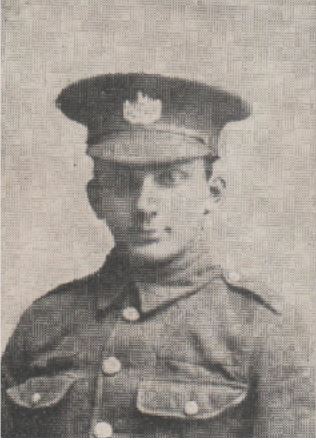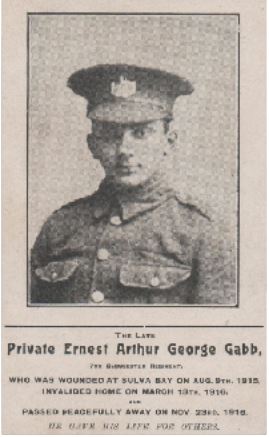7th Battalion, Gloucestershire Regiment

Ernest Arthur George Gabb was born on 22 January 1894, to George and Mary Gabb. Ernest was the youngest of six children. The 1901 Census records that George was employed as a Woollen Worker and the family were living at 7 Stanley Mill Row, King’s Stanley.
The Schools Register records that Ernest was admitted on 31 August 1903 and that he had previously been attending The British School. The family address is given as Stanley Mill.
The 1911 Census records that Ernest was now employed and working in a Cloth Mill, also that the family had moved to High Street, King’s Stanley. Unfortunately, Ernest’s father had died in 1905.
Ernest joined the Glosters in August 1914 and following initial training he was posted to the 7th Battalion. The 7th Battalion sailed from Avonmouth on the 19 June 1915 and landed on Gallipoli the following month. The Battalion took part in the battle of Sari Bair between the 6th and 10th of August 1915, and it was during this action on the 8th of August Ernest was wounded.
Ernest had suffered wounds to his right forearm and right hand which led eventually to the tops of his second and third fingers having to be amputated and the ring finger and little finger being continually flexed. He was also suffering from a chronic cough and laryngitis. Ernest was evacuated from Gallipoli on the MS Aquitania for Mudros on 14 August 1915.
These wounds eventually led to Ernest being discharged from the Army on 13 August 1916.
Sadly, Ernest died on 23 November 1916, aged 22, at home in King’s Stanley. Ernest’s death certificate records that death was due to pulmonary tuberculosis and exhaustion.
On 28 November 1916 Ernest was buried, with full military honours, at King’s Stanley Parish Church; the coffin was draped with the Union Flag and three volley’s fired over the open grave by the firing party.
According to the Medal Roll Index Ernest was awarded the 1915 Star Medal, British War Medal, the Victory Medal and the Silver War Badge.
Unfortunately, the plot where Ernest was buried was not recorded and there is no headstone to show Ernest’s last resting place. At this time, we are in the process of putting a case to the Commonwealth War Graves Commission to allow a headstone to be placed in the grave-yard to read: Known To Be Buried In This Churchyard.

Researched by David Earle March 2021
